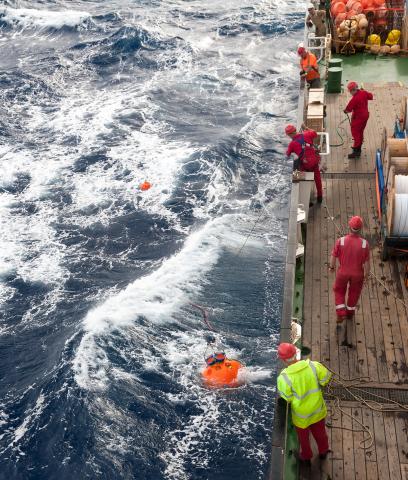
-
Observations of the Atlantic Meridional Overturning Circulation or Gulf Stream System since the 1980s have shown a strengthening in the 1990s and a weakening in the 2000s, with no clear overall trend.
-
Shifts in North-east Atlantic circulation, leading to a greater influence of warmer subtropical-origin waters which can impact marine ecosystems and economically important fish species such as mackerel. The changing subpolar ocean circulation is also having impacts on the food supply for deep-sea ecosystems.
-
The subpolar gyre recorded its freshest values on record in the 2010s. Ongoing freshwater build-up in the rapidly changing Arctic Ocean may exacerbate this freshening.
Medium evidence, medium consensus
Overall confidence for what is already happening is medium (evidence and agreement). There is an increasing amount of data to suggest that certain elements of North Atlantic circulation are in an exceptional state, yet the precise attribution and mechanisms for these long-term trends and the modern AMOC state remain very uncertain. For better knowledge of North West European Shelf Seas circulation, a coordinated program of observations is needed. The largest unknowns are perhaps related more to the biogeochemistry and productivity and annual cycle measurements of carbon, nitrogen and phosphorus cycles are needed.
- Projections from climate models consistently project a weakening of the Atlantic Meridional Overturning Circulation due to anthropogenic climate change.
- Warming of Atlantic waters is expected to reduce the depth of mixed layers and limit nutrient supply to surface layers.
Medium evidence, medium consensus
Overall confidence for what could happen is also medium (evidence and agreement). This takes consideration of a range of factors, including general agreement that the AMOC in the 21st century will be weaker than during the 20th century (medium evidence and agreement), that predictions of an AMOC slowdown by 2100 are robust (high agreement and evidence), and ocean circulation is unlikely to pass a tipping point before 2100 (medium agreement and evidence).
For shelf circulation, changes will manifest through oceanic source water property changes, which require more sustained coordinated observations. Predictions of changes in shelf circulation are also subject to uncertainty due to deficiencies in current models.
Changes in the AMOC
- Reconciling AMOC reconstructions and climate simulations is a key challenge to underpin confidence in future projections
- Focus of understanding circulation change should not focus solely on AMOC with elements such as the subpolar gyre and its driving processes being key to emerging understanding
- Accumulation of Arctic freshwater is a concern since its release could have major consequences for the stability of the AMOC
- Projections consistently show a weakening of the AMOC in the future, but concern exists about whether current models could overlook the possibility of AMOC collapse
- Ocean circulation is the key to predictability on decadal timescales and the leveraging of this skill offers the potential for policy-relevant timescales of forecasting
- Weather and biogeographical impacts of ocean circulation change have been studied but the economic impacts of these changes are not well-understood
Changes in shelf sea circulation
- Features on the continental shelf often have shorter timescales and smaller spatial scales than the open ocean, which causes a challenge for their observation and simulation
- Projections of shelf sea circulation and exchange in future climates needs to be improved through model improvement
- Observations on the shelf need to be sustained and coordinated to validate model simulations and fill fundamental gaps in understanding